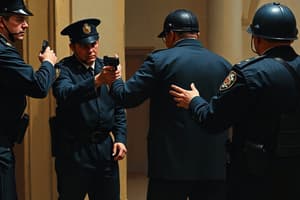Podcast
Questions and Answers
What is the primary purpose of a custodial search?
What is the primary purpose of a custodial search?
- To locate lost items
- To identify personal belongings
- To detect potential weapons or contraband (correct)
- To assess the subject's physical condition
Which technique should be used to conduct a custodial search?
Which technique should be used to conduct a custodial search?
- Circular search pattern
- Random search approach
- Quadrant search approach (correct)
- Vertical search method
What should an officer do first when preparing to search a handcuffed subject?
What should an officer do first when preparing to search a handcuffed subject?
- Search their pockets immediately
- Handcuff the subject first (correct)
- Conduct a pat down only
- Use verbal commands only
What should be done to avoid injury during a custodial search?
What should be done to avoid injury during a custodial search?
Which area is frequently overlooked during a custodial search?
Which area is frequently overlooked during a custodial search?
What is one key aspect of conducting a search in terms of communication?
What is one key aspect of conducting a search in terms of communication?
What is the primary purpose of conducting a pat down?
What is the primary purpose of conducting a pat down?
What type of search can female officers perform on male inmates?
What type of search can female officers perform on male inmates?
Under what condition may an officer conduct a pat down?
Under what condition may an officer conduct a pat down?
What is a common reason for conducting inmate searches?
What is a common reason for conducting inmate searches?
Which of the following is NOT a step to take when conducting a pat down?
Which of the following is NOT a step to take when conducting a pat down?
What does reasonable suspicion involve?
What does reasonable suspicion involve?
What should an officer do to help search concealed areas during a pat down?
What should an officer do to help search concealed areas during a pat down?
What is considered a lawful action during a pat down according to the plain touch/feel doctrine?
What is considered a lawful action during a pat down according to the plain touch/feel doctrine?
Why is it important to be aware of verbal and non-verbal cues during a pat down?
Why is it important to be aware of verbal and non-verbal cues during a pat down?
What is one of the first actions an officer should take when preparing to conduct a pat down?
What is one of the first actions an officer should take when preparing to conduct a pat down?
Under what condition can a male officer conduct a clothed search of a female inmate?
Under what condition can a male officer conduct a clothed search of a female inmate?
What must be done with the inmate's belongings before conducting a clothed search?
What must be done with the inmate's belongings before conducting a clothed search?
What is the primary objective of conducting a clothed search?
What is the primary objective of conducting a clothed search?
Who is authorized to conduct a strip search of an inmate?
Who is authorized to conduct a strip search of an inmate?
What is the first step in conducting a strip or unclothed search?
What is the first step in conducting a strip or unclothed search?
During a strip search, which area is NOT typically searched?
During a strip search, which area is NOT typically searched?
What should officers be cautious of when conducting a clothed search?
What should officers be cautious of when conducting a clothed search?
What may lead to the need for a strip search beyond typical circumstances?
What may lead to the need for a strip search beyond typical circumstances?
Flashcards
Pat Down Technique
Pat Down Technique
A physical frisk of a subject to locate weapons, done in a specific pattern.
Reasonable Suspicion
Reasonable Suspicion
Facts or circumstances that make it likely a person has committed, is committing, or will commit a crime.
Plain Touch/Feel Doctrine
Plain Touch/Feel Doctrine
Allows an officer to seize contraband if its shape and feel are immediately obvious during a pat down.
Custodial Search
Custodial Search
Signup and view all the flashcards
Inmate Search
Inmate Search
Signup and view all the flashcards
Strip/Unclothed Search
Strip/Unclothed Search
Signup and view all the flashcards
Fourth Amendment Concerns
Fourth Amendment Concerns
Signup and view all the flashcards
Stop and Frisk Law
Stop and Frisk Law
Signup and view all the flashcards
Custodial Search Technique
Custodial Search Technique
Signup and view all the flashcards
Quadrant Search Approach
Quadrant Search Approach
Signup and view all the flashcards
Handcuffing First
Handcuffing First
Signup and view all the flashcards
Inmate Search
Inmate Search
Signup and view all the flashcards
Clothed Search (Inmates)
Clothed Search (Inmates)
Signup and view all the flashcards
Strip/Unclothed Search
Strip/Unclothed Search
Signup and view all the flashcards
Body Cavity Search
Body Cavity Search
Signup and view all the flashcards
Weapon Handling
Weapon Handling
Signup and view all the flashcards
Clothed search of female inmate
Clothed search of female inmate
Signup and view all the flashcards
Emergency clothed search
Emergency clothed search
Signup and view all the flashcards
Strip/Unclothed Search
Strip/Unclothed Search
Signup and view all the flashcards
Inmate Arrival Search
Inmate Arrival Search
Signup and view all the flashcards
Clothed Search Procedure
Clothed Search Procedure
Signup and view all the flashcards
Strip Search Conditions
Strip Search Conditions
Signup and view all the flashcards
Same-sex Officer Requirement
Same-sex Officer Requirement
Signup and view all the flashcards
Verbal Commands in Searches
Verbal Commands in Searches
Signup and view all the flashcards
Study Notes
Lesson 7: Frisks and Searches
- Search: Government intrusion into a place where a person has a reasonable expectation of privacy. Inmates and probationers have a reduced expectation of privacy, so searches are less limited.
- Pat-Down Technique: A physical frisk of a subject, conducted systematically to locate weapons.
- Reasonable Suspicion: Necessary before a pat-down; facts or circumstances that reasonably indicate a violation of the law (committing, committed, or about to commit).
- Plain Touch/Feel Doctrine: Allows officers to seize any object whose shape/mass clearly indicates contraband. Search is limited to outside of clothing.
- Pat-Down Procedure:
- Use loud, clear verbal commands throughout.
- Be aware of verbal/nonverbal cues.
- Visually scan the subject.
- Have them lift arms to tighten clothing.
- Have the subject move hands from their body.
- Control their hands.
- Keep them off-balance during a pat-down.
- Conduct the pat down in a predetermined pattern.
- Follow up with appropriate action if weapon is found.
- Custodial Search: Complete search of a person taken into custody; done in an unsecured environment. Handcuffs first, then search.
- Use loud, clear verbal commands throughout the process.
- Keep the subject off balance.
- Physically control subject's hands.
- Search in a predetermined (quadrant) pattern.
- Follow up with proper action.
- Inmate Search: Searches designed to uncover contraband, prevent escapes, maintain sanitary standards, and eliminate safety hazards. Three types: clothed, strip/unclothed, body cavity.
- Clothed Search: Conducted randomly or during emergency, visually checking body areas and items like pockets, shoes, and hats. Female officer can search a male inmate; male officer can search a female inmate when indicated.
- Strip/Unclothed Search: Conducted by officers of the same sex as inmate, visual search only, no touching. Conducted upon arrival, after escape attempt, or if there is a reasonable belief of contraband.
- Body Cavity Search: Typically conducted by appropriate health services staff; must follow agency policies.
Studying That Suits You
Use AI to generate personalized quizzes and flashcards to suit your learning preferences.




